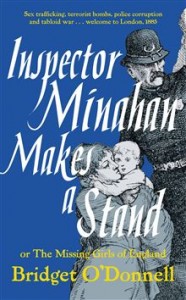 Published by Picador 13 September 2012
Published by Picador 13 September 2012
352pp, hardback, £16.99
Reviewed by Catherine Jones
‘How do you do, Ducky?’
Thus was Jeremiah Minahan addressed by one of notorious brothel keeper Mary Jeffries’ young women; it seems she had little idea she was soliciting a former police inspector planning to take on the political and aristocratic might of London in a campaign to highlight the sex trade of children.
Bridget O’Donnell’s first book is a powerfully researched, impressively detailed picture of 1880s’ London. A former BBC producer and director, O’Donnell has created a masterful jigsaw of lust, power, corruption and do-gooders driven by a variety of motives to do down the arrogant with appetites, as well as to protect working class girls duped and enticed into prostitution.
At the centre of this real-life tale is Minahan – an accomplished and tricky Irish man driven to wreak vengeance on those who destroyed his exemplary career in the Metropolitan Police. Flawed and conscientious, Minahan and his motives are something of an enigma.
A compelling if rather morose hero, he arrived in London from County Limerick, with childhood memories of the potato famine in which one million Irish people died. His career is forged in a London of gravel streets and horse manure, street corner stalls selling coffee and cake, wild dogs, cartwheeling children, ‘bodies that moved like mercury through a maze’ and a Whitechapel of ‘bawds and old trolls, their bullies and their flashmen’. At 39, he is ‘nudging seven feet tall in his blue uniform and custodial helmet’ from ‘a striking brood…the Minahan men in suit jackets…huge hands jut from their sleeves like pale, sleeping shovels’.
But twenty years into policing, Minahan is forced out, days after reporting Mary Jeffries, the owner of a number of brothels attended by the wealthy and influential. At the heart of London’s vice problems were ‘the princes and dukes, and ministers and judges, and the rich of all classes’ who purchased the ‘daughters of the poor’.
Young girls were acquired on demand for men with enough money. Many were trafficked to Europe and Minahan became involved in exposing the abusers when employed as a private detective to aid publisher William Stead, who planned an expose that would scandalize London.
Engagingly written, with a gripping plot, vivid sense of place and the age-old battle of (mainly) good versus evil, this non-fiction account has everything (including 50 pages of notes and a 17-page bibliography). The cast of characters includes cocky crone Jefferies and her coterie of girls in feathered hats and boys in patent shoes as well as aristocratic politicians with sordid secrets.
In many vividly drawn scenes, as wily as anything in Dickens, we also meet the formidable campaigner, Josephine Butler – labelled the leader of the ‘shrieking sisterhood’ – fighting for the repeal of the Contagious Diseases Acts (which meant infected women were forced to stay in a lock hospital for up to nine months) In addition, the Unitarian Church became involved in exposing exploitation, espousing their own fight for female suffrage, a woman’s right to work, and the progressive notion that fathers should share the care of their children.
A kaleidoscope of human woe, politics, debauchery, crusading, and social change, it’s the perfect autumn read. Just spare a thought for the real-life children who haunt this book, and for Minahan too. There is a poignant twist in the tale.
